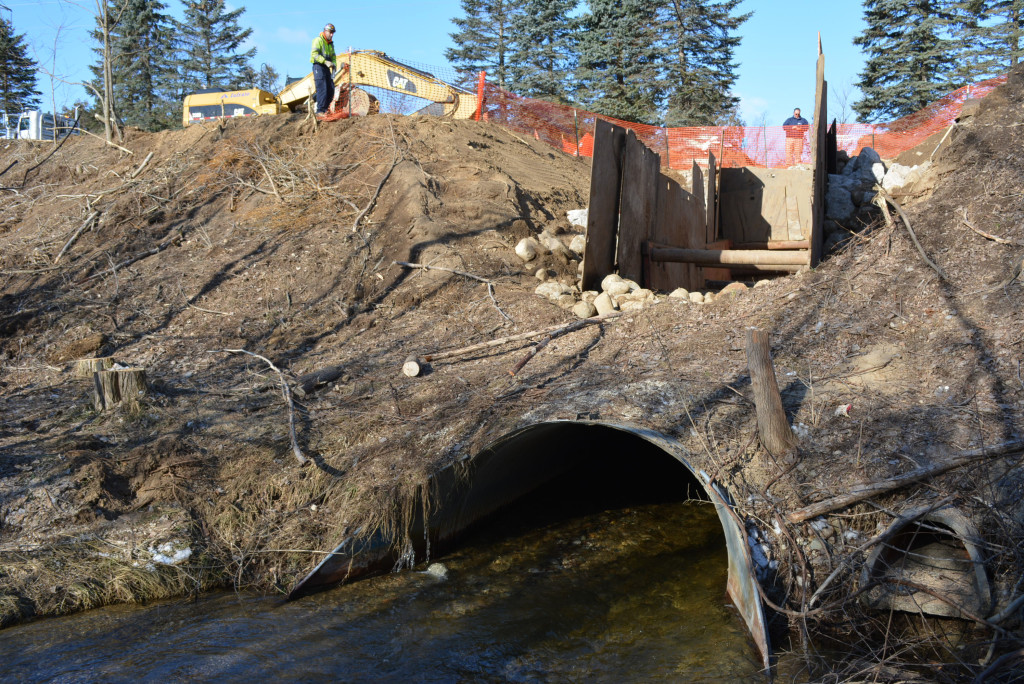
OXFORD TWP. – Paint Creek is once again flowing beneath the section of Wood Trail where a massive sinkhole opened up on Feb. 24-25, but it’s going to be a while longer before the severely-damaged road is rebuilt and traffic can use it.
“Wood Trail is going to be closed probably until at least mid-May. So, about another 60 days,” said township Engineer Jim Sharpe.
Last week, the contractor being used by the Road Commission for Oakland County (RCOC) created a trench to restore the flow of Paint Creek from the west side to the east side of the road.
“It’s flowing very well through there,” Sharpe said.
The creek had stopped flowing when a portion of a corrugated metal pipe (CMP) culvert beneath Wood Trail collapsed, causing the dirt above it to give way and form a large, water-filled hole along the east side of the road. It was discovered and reported on Feb. 24.
Since then, the portion of Wood Trail between Watersmeet Dr. and Chesnut Ct. has been closed to through-traffic.
In a March 13 e-mail, Jeff O’Brien, a design engineer for the RCOC, provided a “tentative schedule” for replacing the failed culvert and rebuilding the damaged road, which includes seeking bids by the end of March/early April, then awarding the contract and doing the work between early April and mid-May.
As the hours passed following the sinkhole’s discovery, the dirt beneath Wood Trail slowly gave way, causing the asphalt surface to sag as it lost more and more of its support. Finally, at approximately 12:30 p.m. Feb. 25, the pavement buckled and fell into the water, more than doubling the size of the hole.
While all this was happening, water that was no longer able to flow through the damaged culvert had already begun to back up and flood a large area west of Wood Trail and the Polly Ann Trail. The water in this flooded area, adjacent to some homes in the River Walk subdivision, was originally estimated by officials to be about 20 feet deep.
With the water encroaching upon these homeowners’ properties, the road commission hired a company that brought in seven large, diesel-powered pumps to lower the level of the flooded area and move the water to where the creek typically flows when the culvert is functioning properly.
This water comes from the Oxford Multi-Lakes Dam, which is operated by the Oakland County Water Resources Commissioner’s (WRC) Office. The dam controls the lake levels for Tan, Squaw, Cedar, Clear, Long and Mickelson lakes.
To help keep the water in the flood area from rising anymore than it already had, the WRC shut down the Multi-Lakes Dam on Feb. 25 and it remained completely closed until the rain and snow Oxford received on March 1 required opening it about 2 inches.
With the normal flow now restored through the trench, Lisa New, a project engineer with the RCOC, reported, in a March 16 e-mail, that “all the pumps” have been “removed.”
The area to the west of Wood Trail is no longer flooded.
“(The) WRC has opened the dam up somewhat and the trench has been handling the water flow accordingly,” New wrote. “(The) RCOC will monitor the water level and the open trench until the permanent culvert (is) installed within a few weeks.”
During last week’s township board meeting, Treasurer Joe Ferrari informed his fellow officials that based on his conversation with Tom Noechel, programming supervisor for the RCOC, “the county’s looking at us for funding half of” the Wood Trail project.
“By law, they can only fund 50 percent. They’re coming back to us for the other 50,” Ferrari said. “I’m telling you right now, so it’s not going to be a shocker when you get a bill for that because they’re going to want somebody to pay that.”
Noechel confirmed that’s what he and Ferrari spoke about, but noted “there’s been no commitment either way.”
“Per (Public) Act 51 (of 1951), any improvement on a local road, which Wood Trail is, requires that we split the cost 50/50,” Noechel explained. “This wouldn’t be a maintenance-type function. This would be an actual culvert replacement, so we’re talking about a construction project. We’re simply being consistent with state law.”
“The law doesn’t distinguish between a planned improvement or a budgeted improvement, an act of God, or an accident,” Noechel noted. “Regardless of (what) caused the (culvert) collapse, in terms of the (subsequent) improvement, that is what the law requires.”
Township attorney Gary Rentrop disagreed with the RCOC’s interpretation of Act 51. He believes it doesn’t apply in this case.
“They are reading that act as if it applies to townships and it does not. It applies to counties, villages and cities, but it doesn’t apply to townships,” he said.
“The concept of Act 51 was the county would come up with 50 percent and the local municipality would come up with 50 percent,” Rentrop continued. “Since it’s in the township and townships can’t own roads, they can’t come up with 50 percent, so the county’s not going to be restricted to (paying) 50 percent.
“Act 51 doesn’t even mention the word ‘township.’ But it mentions how cities have to come up with the money and villages have to come up with the money.”
Township Supervisor Bill Dunn told this reporter he doesn’t believe Oxford is obligated to pay a penny for the Wood Trail fix.
“We don’t own the roads. The county does. We don’t maintain the roads. That’s the county’s responsibility,” he said. “The road commission’s replaced culverts. They’ve done work on bridges. They’ve never charged us for any of that work before. I don’t see why the township would have to pay now. There’s something stinky here.”

Leave a Reply